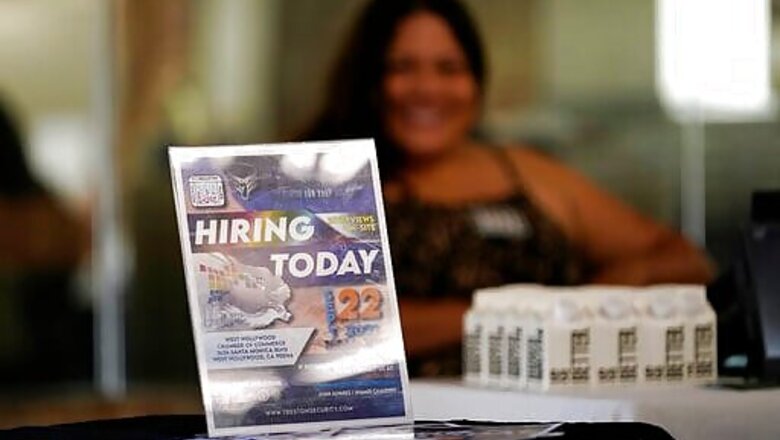
views
WASHINGTON: September wasn’t exactly the robust month for hiring that many had expected and hoped for.
With the delta variant still disrupting the economy and employers struggling to find enough workers, the gain for the month amounted to 194,000 jobs not even half of what economists had expected. In August, the economy had added a modest 366,000 jobs. Taken together, hiring for the past two months marked a steep drop-off from the 962,000 jobs that were added in June and the 1.1 million in July.
The job market has endured wild swings since COVID-19 hammered the United States beginning in March 2020, triggering a short but harsh recession that erased 22 million jobs. Since then, employers have added back 17 million jobs as huge infusions of federal aid put money in peoples pockets and the rollout of vaccines gave many the confidence to return to shops, restaurants and bars at least before the delta variant erupted.
Last month, private-sector businesses added 317,000 jobs, down from 332,000 in August and from a January-July average of 553,000. The leisure and hospitality sector, which includes the hotels, restaurants and bars that were most devastated by the pandemic, added 74,000 jobs. Though that figure was up from 38,000 in August, it fell far short of the January-July average of 296,000 a month.
Friday’s employment news wasnt all bad. The Labor Department revised up its hiring estimate for July and August up by a combined 169,000 jobs. And the unemployment rate dropped to 4.8% in September from 5.2% in August.
In normal times, 194,000 jobs would be considered a decent monthly gain. But as Robert Dye, chief economist at the Comerica banking company, noted: These are not normal times. A further disappointing result in October would suggest that this is a fundamentally different labor market than what we thought a few months ago.
Here are five takeaways from the September jobs report:
DELTA TAKES A TOLL
From January through July this year, employers had added a sizzling average of more than 640,000 jobs a month. Then delta hit. COVID-19 cases began rising again and weakening the economic rebound. Job growth decelerated in August and September. Since mid-September, though, confirmed COVID cases have been dropping, possibly setting the stage for the job market’s recovery to regain momentum.
This is quite a deflating report,” said Nick Bunker, director of economic research at the Indeed Hiring Lab. The hope was that August was an anomaly, but the fact is, the delta variant was still with us in September. One optimistic interpretation is that COVID-19 case counts are receding, so future months should be stronger. But the reality is that we are still in a pandemic.
BEHIND THE DROP IN UNEMPLOYMENT
The unemployment rate tumbled to 4.8%, the lowest level since March 2020. But the reasons for the drop were a mix of good and not-so-good.
The good: The number of people who reported that they were employed jumped by 526,000 last month. And those who reported being jobless fell by 710,000.
The not-so-good: One reason the unemployment rate slid was that 183,000 people stopped looking for work last month and were no longer counted among the jobless. The share of Americans who either have a job or are looking for one the so-called labor force participation rate slipped to 61.6% in September. Before the pandemic, the participation rate had exceeded 63%.
Economists dont know exactly why so many Americans have chosen to stay on the labor market sidelines even as demand for workers surges. Some may have lingering fears about becoming infected while handling public-facing jobs.
Others are struggling with childcare arrangements at a time when school schedules are so uncertain. Some have chosen early retirement or are taking time to rethink their careers after spending time locked down with their families during the pandemic.
HELP WANTED
Hiring has slowed partly because companies simply cant find nearly as many workers as they need.
Labor availability remains the biggest challenge to hiring right now, Wells Fargo economists Sarah House and Michael Pugliese said in a research note.
In July, employers posted a record 10.9 million job openings and struggled to fill them.
Businesses had hoped the labor shortages would ease and the jobless would look more eagerly for work after the federal government last month ended enhanced aid for the unemployed, including an extra $300 a week on top of state benefits. But the end of federal aid doesn’t appear to have had much of an effect so far.
Likewise, supply shortages, caused mainly by the unexpected speed with which the economy rebounded from last years coronavirus recession, have prevented companies from being able to operate at full strength.
SCHOOL SQUEEZE
September’s overall hiring was pulled down by the loss of 144,000 jobs at local public schools. The drop, however, reflected the way the Labor Department adjusts the numbers to account for seasonal fluctuations.
The upshot: Schools actually were hiring though less than seasonal models had suggested they would perhaps because of previous COVID-related closings or shortages of available teachers.
As we feared, fewer teachers were hired than in typical years despite many schools reverting to in-person learning, Lydia Boussour and Gregory Daco, economists at Oxford Economics, said in a research note. This corroborates anecdotal evidence of schools struggling to find qualified teachers amid lingering virus fears and early retirements.
IMPROVING PROSPECTS FOR ALL RACES
White, Black and Hispanic workers all benefited from last month’s job market.
For whites, the ranks of the employed rose by 326,000. The number of unemployed fell by 436,000. And the unemployment rate dipped from 4.5% to 4.2%.
For Black Americans, the number of people with jobs rose by 104,000. The jobless fell by 187,000. And the unemployment rate slipped from 8.8% to 7.9%. On a percentage basis, employment for African Americans grew twice as fast in September as it did for whites 0.6% versus 0.3%.
For Hispanics, the improvement was more modest: The number of employed rose by 86,000. The number of unemployed slipped by 2,000. And the unemployment rate ticked down from 6.4% to 6.3%.
___
AP Economics Writer Christopher Rugaber contributed to this report.
Disclaimer: This post has been auto-published from an agency feed without any modifications to the text and has not been reviewed by an editor
Read all the Latest News , Breaking News and IPL 2022 Live Updates here.


















Comments
0 comment